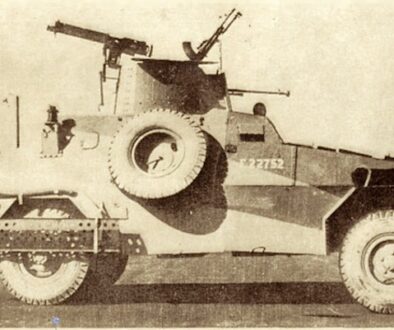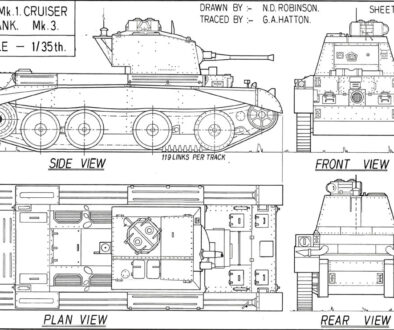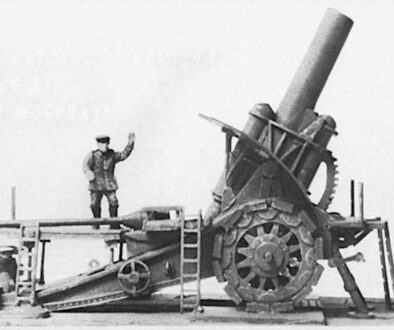Realistic Buildings and Façades
Emmanuel Nouaillier
Shows how to scratch build and age miniature structures
In order to set my modelling efforts into context, I think it would be useful to give you some background which should help you understand the reasons for the choice of proceeding outside the normal presentation of ‘military modelling’, as it’s habitually practiced, where armoured vehicles are introduced in the middle of ruins – sometimes very realistic, but often showing kits of houses, buildings, that are ready to build and paint. My approach is different. Inspired by the wish to capture ‘atmosphere’ in miniature, I have always made dioramas that in the course of the time have revealed an artistic approach.
Having spent a long time with general military modelling and then turning to figures for a while, I decided a few years ago to make my first diorama that had as its only topic a very shaded, old urban and industrial ambience. Applying the methods of painting and ageing I’d learnt, and building the scenes for their’ visual aspect’,my only fixed idea was to be very close to reality as possible in the effects of decay and deterioration of building materials and all this in 1:48 and 1:72 scales. l have come a long way since that first experience and I have also discovered the possibilities offered by some unknown, or rather lesser known, materials for creating many desired elements on which I like to simulate ageing effects and create an overall drab aspect. Generally; to create miniature buildings l have relied upon four main materials: feather board (polyurethane foam sandwiched between two sheets of card), Forex (a light expanded PVQ, coating and plastic card.

Some of the basic tools that I use to work the foam and give it some aspects and different alterations in scale. The fine wire brush is used to produce a good looking surface finish in particular cases

To emboss bricks or cobble stones in to the foam, I've made tools from old paint brushes with no more bristles left, and shaped the ferules in to the form desired with fines pointed pliers.
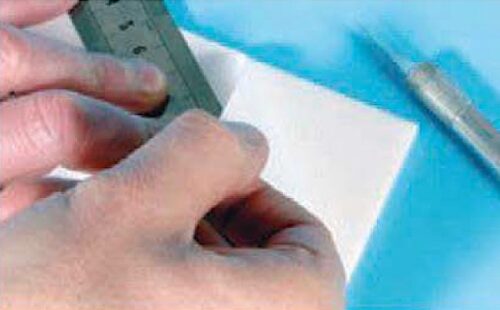
Peeling off the outer card of FeatherBoard will be very interesting for the modeller who wants to create his own brick wall, concrete surface or cobbled street.
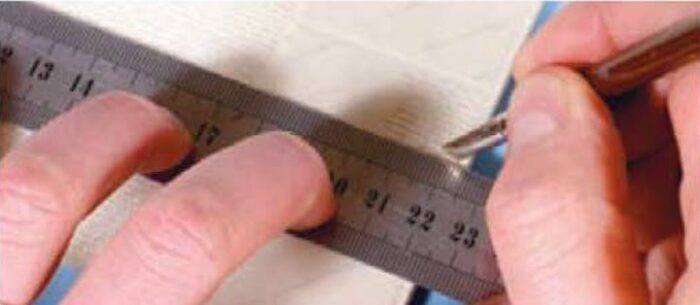
For cobblestones and stone sets, pressing one of the tools into the foam individually reproduces the stones. If you wish, you can stamp with deeper cuts for deeper joints, carve off missing bricks or reproduce holes with the point of a needle.


Embossing can take a long time, especially if one undertakes to reproduce large brick buildings. This finished example is part of the façade of an industrial warehouse.
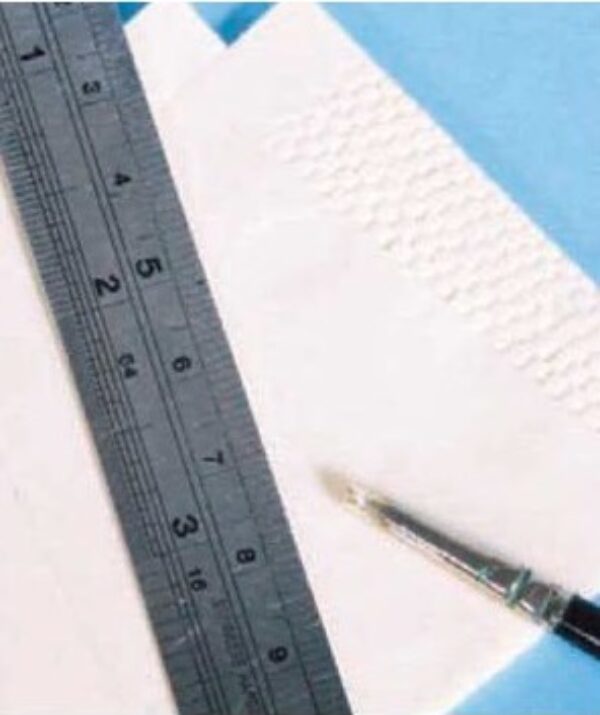
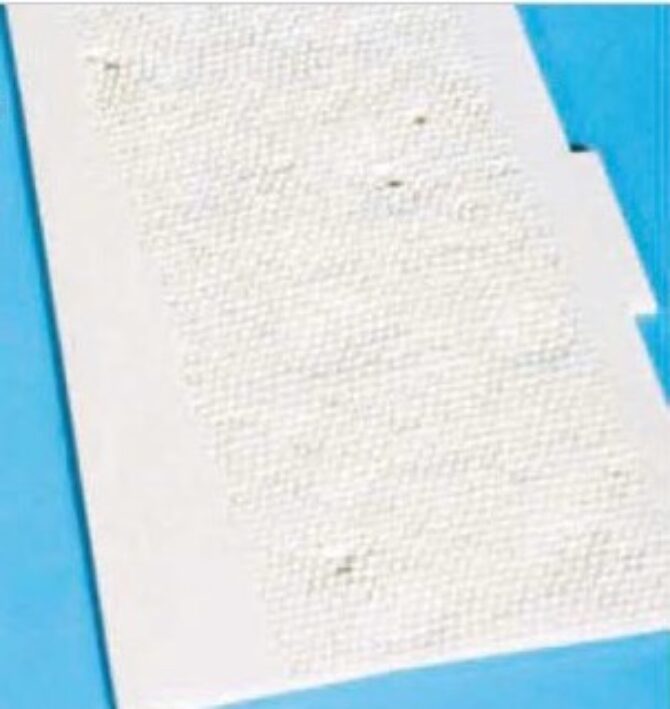
Creating a cobbled street with its typical dips, displaced cobbles and uneven surface will be easy by employing this technique. Here you can see a part of a street in 1:72 scale in the course of being worked

Applying a layer of coating onto foam to simulate the façade of a particular building will perfectly convey the decay and the state of degeneration
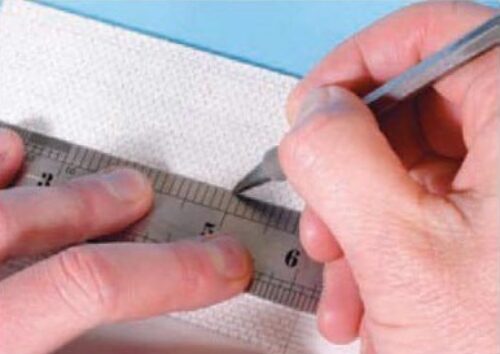
Scribing brick bonds in plaster onto Forex can be a tedious work, but it produces the texture that will help to create typical buildings or parts of them. Aa for the red bricks, some realist alterations and additions will be added by engraving.
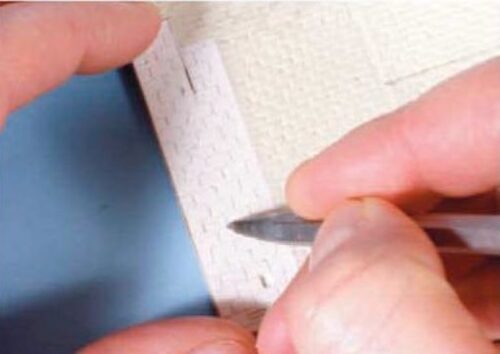

Using plastic card to reproduce all sorts of features is well-knoiwn to us modellers, especially to improve vehicle kits. There are also numerous applications for plastic card in the urban landscape as seen here. These metal framed windows with broken glass panes in 1:48 scale were made to fit into the façade of an old factory.

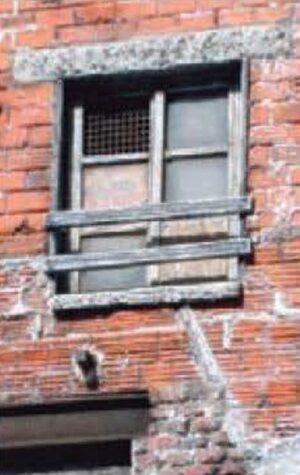

Applying a layer of coating onto foam to simulate the façade of a particular building will perfectly convey the decay and the state of degeneration
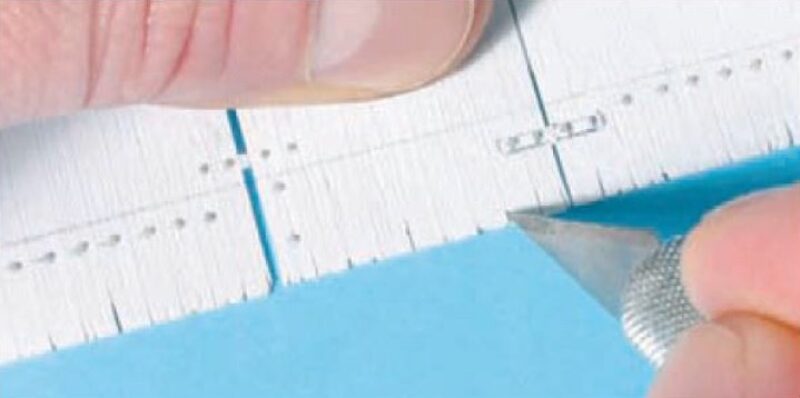
Scribing bonto plastic card will allow you to create doors with the appearance of decay and dilapidation by performing some incisions or engraving some of the joints a little deeper… Like this old garage door I made in 1:48 scale.
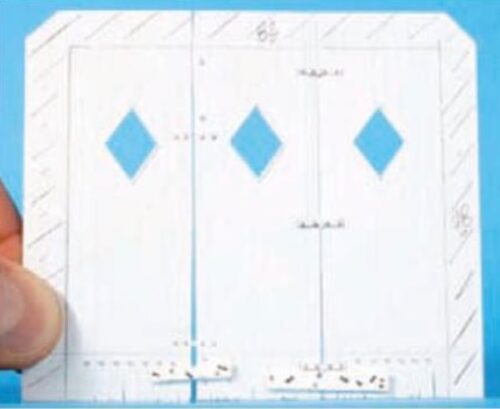
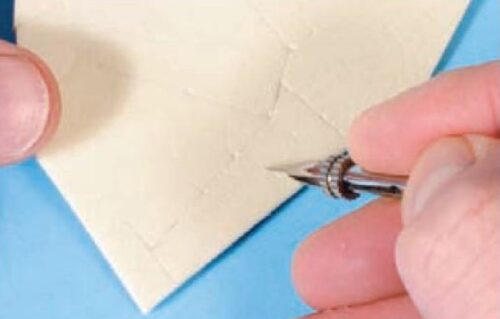

Here’s part of a concrete yard in 1:72 scale in the course of being worked. Fissures and joints are made with an engraving point and the point of a needle. An attractive surface finish will be later given with a fine wire brush. The surface after painting and ageing where the porous mixture of the foam is wholly adapted t0 represent this kind of material. Details such as sewer hatch covers, manhole and other small covers, etc., are treated with pigments and graphite powder to enhance their surface finishes.


ABOVE and LEFT:
Other results of faded and weathered paintwork on wood with variations in the planks, different shades of colour, rotten planks and so on.

Convincing chipped paint in 1:72 scale needs some skill on the part of the modeller. Check out the result of this garage door in the course of being detailed with old metal plate
Feather Board
Feather Board is made with a central core of polyurethane foam between two layers of thin card.It is perfectly flat, even over large areas (one metre square) and very light. It is available in various thickness (3mm, 5mm and10mm) and I get mine from www.x.ebulon-vpc.mm The foam core is compatible with all sorts of adhesives as well as all paints that we use for modelling. Used as it comes, this material is perfectly suited for creating the basic shell of a building, then you can glue embossed plastic sheets or card onto it, or apply a layers or coats of plaster to simulate the façades of particular urban buildings or any specific decorative features.
There is another less-known, yet very interesting method, which involves peeling off the outer carcl. Thanks to the nature of the foam, it can be scribed, worked, embossed with the aid of hand-made punches, ‘matrixes’ or ordinary tools such as scribers, blunt scalpel blades, points of needles, fine wire brushes, etc. Thus it’s possible to obtain all sorts of effects and tomake cobbled streets, brickwork, concrete, and stones, as required, to reproduce streets, pavements and all sorts of façades and buildings. In addition to this, the nature of the foam is well-suited to imitating the surface of the brick,the finish of the stone,or the texture of concrete. Furthemore, for a cobbled street you are able to reproduce the worn patches caused by road traffic by simple depressions in the foam, or to imitate cracks in brick walls due to stress, and breakage of the rendering between the bricks.
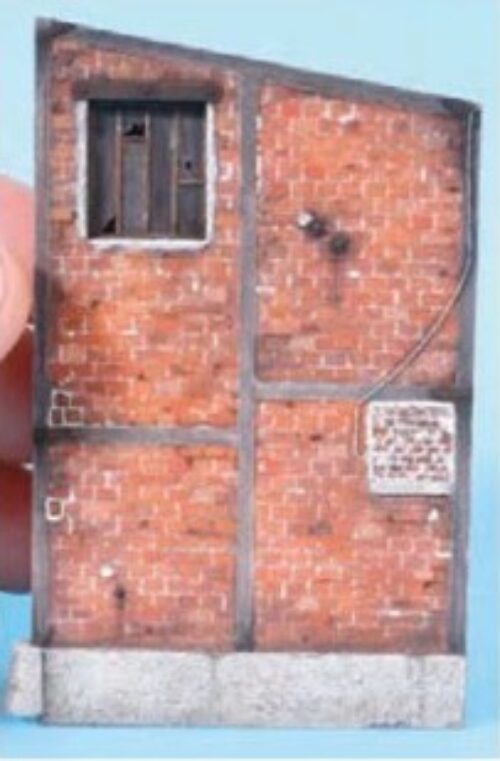
These walls seen after the painting and ageing phase clearly show the results obtained to represent building that shows long time weathering by the elements
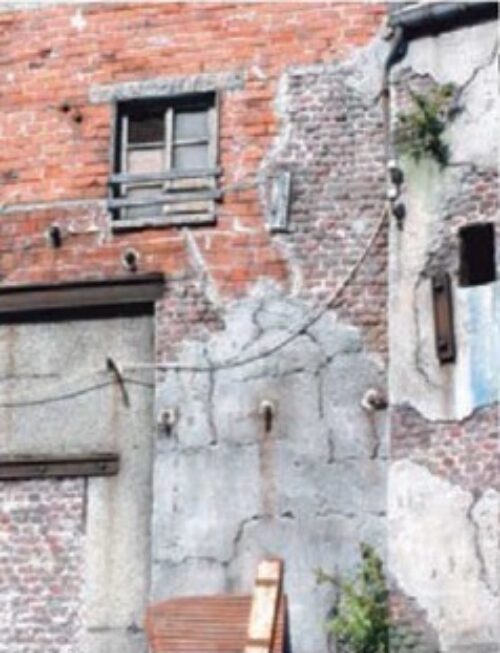
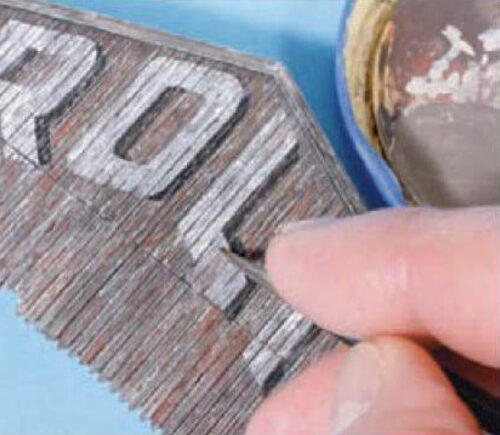
The micro painting stage is required to reproduce the faded paint of lettering on wood cladding for extra realism as well as the weathered paint of an old advertisement on the cracked plaster of this façade

Forex
Forex may be an unfamiliar product to most modellers. It is a lightly expanded PVC and mmes in sheets, which are perfectly flat. It is used principally for shop fitting, but can be very useful for modelling purposes,notably thanks to its surface finish, which is less smooth than plastic and slightly softer. Like feather board it can be obtained in various thicknesses; 1/2/3/4/5mm and like feather board this material is easy to glue with contact adhesive or cyanoacrylate and used in this way Forex is also ideal for reproducing basic shells. I use Forex for reproducing very precise construction materials, whether scribing it with tools or using it without any fom1 of specific treatment (architectural details where the natural ‘finish’ of the product makes it suitable for imitating window sills or cement rendered façades.
In addition to these applications, the material can be scribed and shaped, which should appeal to the modeller who wants to reproduce certain types of brick bonds in plaster, but the possibilities are evidently and not just limited to the simulation of this type of brickwork.
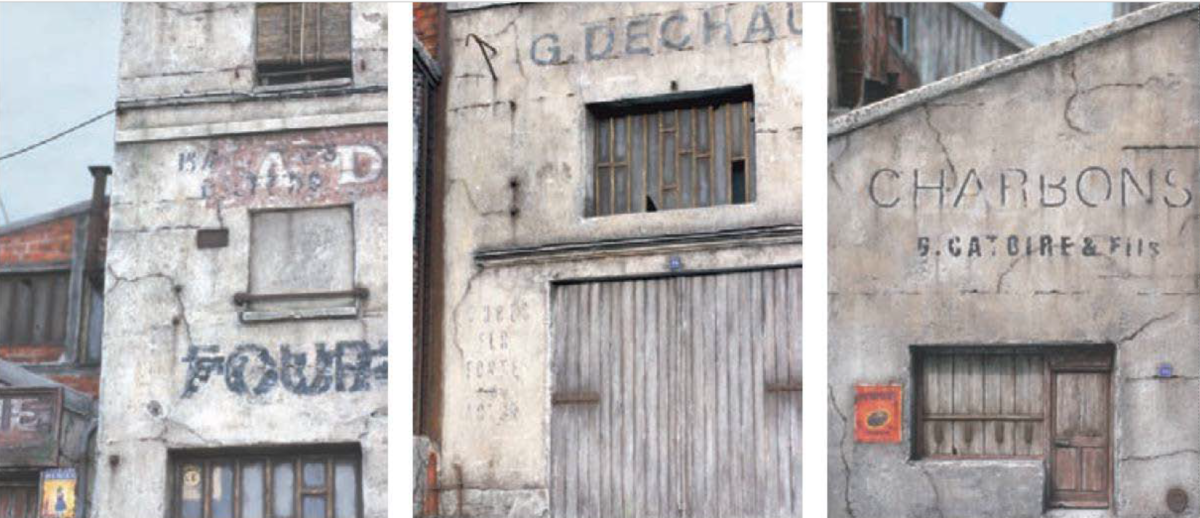
Some finished 1:72 scale façades created using foam, coating and scratch build detail
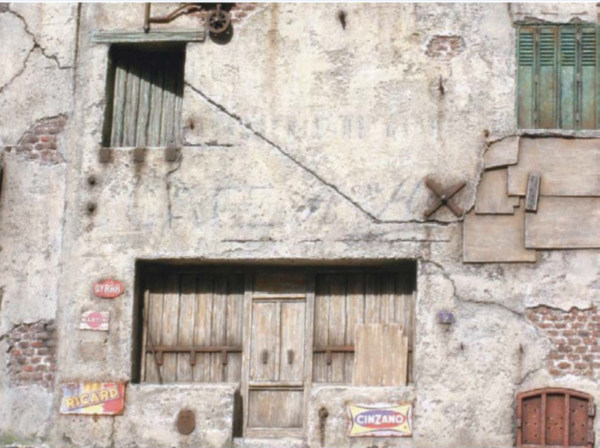
Plastic card and ‘micro-painting’
In my case, plastic card is principally employed for scratch building particular elements in urban or industrial landscapes (yard gates, doors to complete warehouses, etc.) or detailing buildings where I sometimes use Evergreen styrene sections. However, I also use plastic card for another application – scribing it to represent fine wood grain. Why? In the first place the grain of even close grained real wood is still too big and doesn’t look right when used in small scale buildings. In the second place, plastic card isa material with which most of us are used to working, painting and weathering. Turning to the weathering process, the ‘micro-painting’ phase is a widely used and well known-method that will be useful on particular details and elements in the urban landscape. This technique employed only for some weathering effects or to mimic precise alterations on wood, metal, plaster, cement, etc., will add a realistic touch that makes the result different. I use it to reproduce washed paint on wooden cladding, the rusted areas of a sliding door, chipped paint of old advertisements painted on walls, the shades of decay on a façade.
By kind permission of Doolittle Media. Originally published in Military Modelling

